
If you’ve been to the Azores, a remote archipelago of nine Portuguese islands in the middle of the Atlantic Ocean, you’ve probably made it to the main island of Sao Miguel. If you’ve dared to venture deeper off the beaten path to outer islands like Faial, then you know what it’s like to be welcomed into a world of pure magic and endless intrigue.
Known as “The Blue Island” for its abundance of summer hydrangeas blooming along hedgerows, Faial is part mystery, part cosmopolitan mecca. It was integral for transatlantic telecommunications in the 19th and 20th centuries, became strategic during World War II, and has withstood tumultuous seismic and volcanic activity for millennia. Today, its rolling cow pastures, rich sailing culture, and inviting people offer an authentic place to relax, let go, and truly get away. Best of all, it’s closer than you might think. Read on to discover secret Faial and one of the most memorable ways to see it: in a jeep—windows down—with a native islander as your guide.
Image Gallery
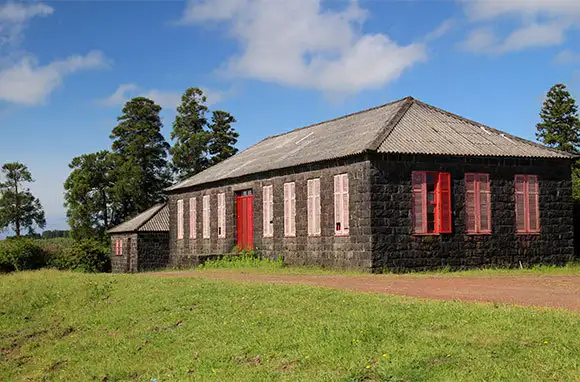
Agrarian Lifestyle
When I hopped into the Casa d'Ávilas Land Rover for my island tour, I immediately noticed a container of perfectly ripe strawberries on the console between the front seats. My guide, Filipe Ávila, said to me, "They're for you; they're organic and from my family's farm." This small gesture signified what was to come: a day traversing the island while listening to stories about the people who have toiled on the land and now enjoy a new prosperity, one they are willing to share openly with visitors.
Faial's agrarian way of life dominates its landscape, which is blanketed by a patchwork of verdant pastures. Ever peaceful and free of crowds, you're likely to see more cows than people enjoying the views. Part of the Azores' Central Group, clustered closely with fellow "Triangle Islands" Pico and Sao Jorge, Faial is the third most populous island in the Azores, with around 15,000 inhabitants. However, years ago, the population was reduced by almost half due to economic hardships and a mass exodus in 1958 after a volcano spread ash over much of the farmland, making it untillable. While the island never fully recovered in terms of head count, agriculture remains one of its most important industries, particularly the production of high-quality produce, grains, and cattle (including the endemic Ramo Grande breed) for beef and dairy.
Island tours reveal engaging aspects of Faial's agrarian past and present. On breezy drives through the countryside, you can observe abandoned but still beautiful atafonas (pictured), stone storehouses once used to keep animals and farming tools. You can also pass by working farms and stop to sample the island's vast bounty, which is cause for much celebration today.

Agrarian Lifestyle
When I hopped into the Casa d'Ávilas Land Rover for my island tour, I immediately noticed a container of perfectly ripe strawberries on the console between the front seats. My guide, Filipe Ávila, said to me, "They're for you; they're organic and from my family's farm." This small gesture signified what was to come: a day traversing the island while listening to stories about the people who have toiled on the land and now enjoy a new prosperity, one they are willing to share openly with visitors.
Faial's agrarian way of life dominates its landscape, which is blanketed by a patchwork of verdant pastures. Ever peaceful and free of crowds, you're likely to see more cows than people enjoying the views. Part of the Azores' Central Group, clustered closely with fellow "Triangle Islands" Pico and Sao Jorge, Faial is the third most populous island in the Azores, with around 15,000 inhabitants. However, years ago, the population was reduced by almost half due to economic hardships and a mass exodus in 1958 after a volcano spread ash over much of the farmland, making it untillable. While the island never fully recovered in terms of head count, agriculture remains one of its most important industries, particularly the production of high-quality produce, grains, and cattle (including the endemic Ramo Grande breed) for beef and dairy.
Island tours reveal engaging aspects of Faial's agrarian past and present. On breezy drives through the countryside, you can observe abandoned but still beautiful atafonas (pictured), stone storehouses once used to keep animals and farming tools. You can also pass by working farms and stop to sample the island's vast bounty, which is cause for much celebration today.

Island Gastronomy
From mouth-watering cheeses to the freshest catch from the sea, Faial's gastronomic treasures come in both traditional and progressive forms. For total immersion, sample typical dishes like stewed octopus, limpets (a type of mollusk), and beef stew spiced with cumin and cinnamon—all best served with bread or corn cake and wine from nearby Pico. Rumar, a laid-back island cafe in Praia do Norte and a favorite jeep-tour stop, specializes in dishes made with peixe-porco (triggerfish) and espadarte (swordfish) but will also treat you to a relaxing view through tall windows that look out to the idyllic town of Faja and the sea.
While leisurely meals run on island time, island ingenuity is in season for the locals who use Faial's abundant resources to create new handmade products. Case in point: Queijaria O Morro, an artisanal cheese factory started in 2012 by Rui and Nuno Caldeira. Although the two brothers have an agricultural background, making cheese was a new endeavor for them. After working through early challenges, they now produce some of the island's best, including Queijo Curado Amanteigado (pictured), a soft ripened cow's milk cheese that came out softer than initially intended but is unquestionably addictive; just cut the top off, scoop out the creamy center, and taste for yourself.
Packing for a picnic? Then follow the local-foods trend. In the main city of Horta, Loja Do Triangulo, which translates to "Triangle Shop," is part of a cooperative and stocks anything you could want for an island feast. Its mostly organic products hail from Pico, Sao Jorge, and especially Faial. Find wooden shelves lined with homemade wheat breads and jams, tidy piles of garden-fresh fruits and vegetables (like those strawberries), and cases of meats and cheeses direct from regional farms.
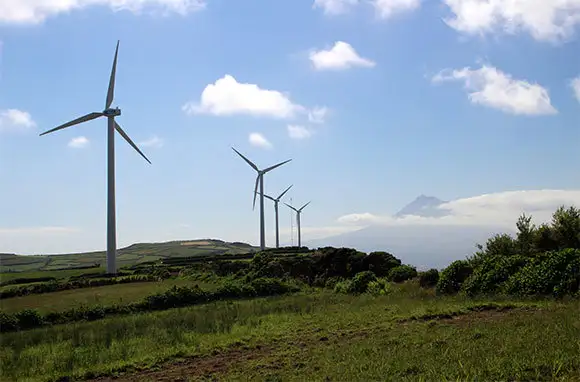
Sustainable Faial
The land yields bounty and bucolic scenery, but it is also cared for through conservation and other environmental initiatives. Established in 2007, Faial Nature Park includes 13 protected areas that foster education and enjoyment for tourists and locals alike. For example, the Botanical Garden in the Flamengos valley is home to a significant collection of endemic plant life (plus 30 different species of orchid), a seed bank to preserve rare and endangered Azorean flora, and a living museum of traditional crops and medicinal plants. Other nature reserves—including Morro de Castelo Branco, a prime location for spotting seabirds and maybe even bats, and Caldeira do Faial, where you can descend into a volcanic crater—render Faial Nature Park a hiker's paradise.
While rolling along in the jeep, you might encounter eco-fabulous surprises, such as Faial's wind farm (pictured) and its meditative turbines that rotate gracefully above the countryside. Although it will be a while before Faial and most of the other islands achieve 100 percent sustainable energy, the Azores as a whole recently won a QualityCoast Gold Award as a sustainable tourism destination and is making strides with green energy. That's all good news for islanders and eco-conscious travelers who want to explore the land and feel good about it, too.

Caldeira Do Faial
Standing on the edge of Caldeira do Faial might make you feel small, but the sight of the crater commanding the island's center will likely have a big impact. With a diameter that's roughly 6,500 feet and a depth of 1,300 feet, the volcano—which arose from the ocean to create the island—is simply massive. Climb to the top of this popular tourist site to take in views of Horta and the neighboring islands, then look down into the belly of the crater to make out the outlines of a mini volcanic cone and a marshy lake at the bottom. No matter from which perspective you view it, the caldera's undulating shades of green seem to change as the clouds move, making the now-dormant volcano appear very much awake and active.
On a hike around the rim, which can be part of a guided tour, you can brush past Faial's signature blue hydrangeas and other Azorean flora and observe the island's intense biodiversity as you meander along the footpath. Designated as a reserve and part of Faial Nature Park, Caldeira do Faial is one of the last remainders of the native laurel forest (a type of subtropical forest found in mild climates like the Azores) that once covered the entire island.
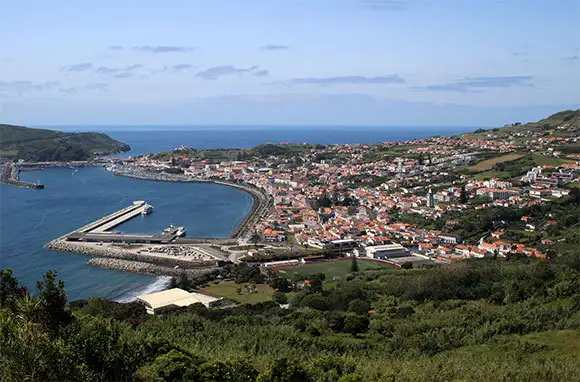
Horta
Due to its prime position in the Atlantic, Faial is as cosmopolitan as it is rural, especially in the city of Horta, where an alluring mix of Old World charm and modern sensibility invites you in. Set along the harbor on the island's southeast coast, the lively hub is steeped in history and once served as a pioneering center for international communications. In 1893, when the first submarine telegraph cables were laid, the city became a relay station, hosting German, English, and American telecommunication companies. In 1915, the opening of the Prince Albert Weather Observatory bolstered Horta's importance yet again, this time for rapid transmissions of meteorological data and, later, seismograph recordings. The city also became a safe harbor for ships (and airplanes) crossing the Atlantic, and it was even a naval base for Allied troops during World War II.
Now, Horta's cluster of whitewashed buildings with red tiled roofs, sloping upward to the hills, house friendly cafes, museums, and other local businesses. In line with the rest of the island's vibe, there are only a handful of hotels—such as Hotel do Canal and Pousada da Horta (set in a 16th-century fortress)—ensuring that Faial won't be overrun by tourists. Horta's port is the jumping-off point for ferries connecting Faial to Pico and Sao Jorge, and its airport, just outside the city in Castelo Branco, offers interisland as well as international flights. SATA airlines flies to Faial (via Sao Miguel) from North American cities like Boston, which is only about a four-hour flight away.
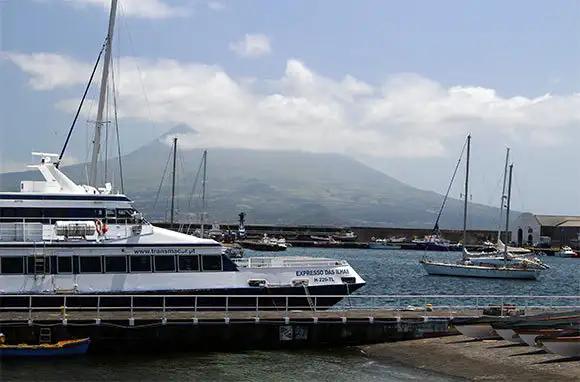
Horta Marina
Sails, seafarers, and sea legends. That's what Horta Marina is made of. Inaugurated in 1986, it's one of the most famous and busiest marinas in the world. Yachtsmen from all over sail across the Atlantic and rest their seaworthy vessels in the 300 or so available mooring spaces. Tradition and superstition encourage them to paint murals on the breakwater to guarantee a safe onward journey, transforming the gray cement jetty into an open-air gallery showcasing a vivid mosaic of artwork. The Blue Flag marina is also a center for diving and whale watching. Outfitters like HortaCetaceos share their passion for the island's rich marine ecosystem through education and tours that allow you to get up close and personal with dolphins and other sea creatures—responsibly, of course.
Walk along the promenade to see rows of boats docked in slips and flying flags of every color from around the globe. And while the common saying that "the best thing about Faial is the view of Pico" hardly seems fair (given everything Faial has to offer), you won't be able to deny that the sight of Pico's immense volcano from Horta Marina is stunning.
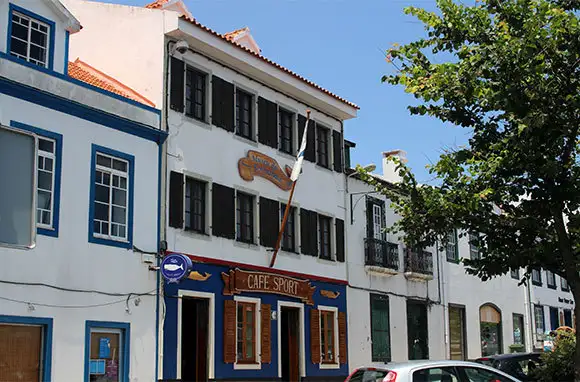
Peter Cafe Sport
To echo a phrase commonly sounded by yachtsman, you haven't really seen Horta if you haven't stopped at Peter Cafe Sport. Opened in 1918, the sailors' bar and coffeehouse sits along the marina and is one of the most well-known watering holes in the North Atlantic. But this storied spot has always been more than just a bar: It has functioned as a base for Dutch tugboat crews, a post office, a currency exchange, a scrimshaw museum, and, of course, a major draw for yachtsmen and travelers. Outside, a carving of a whale hangs against the blue facade (colored with the same paint traditionally used for Dutch vessels) and welcomes you. Inside, the worldly display of pennants and other sailing memorabilia lining the walls and ceiling, coupled with the sounds of pop music, make Peter's instantly relatable. The most popular drink served? Gin and tonic, thanks to the influence of Brits who worked for the area's telegraph cable companies years ago.
The cafe got its name during World War II, when Jose Azevedo, son of the owner, was nicknamed "Peter" by an officer on the Lusitania II. After that, the name stuck. Today, the Azevedo family continues to take good care of the many crews—and tourists—who walk through Peter's doors.

Ponta Da Ribeirinha Lighthouse Ruins
Also looking out for sailors (and their ships), lighthouses dot Faial's coastline and keep a constant vigil. However, Mother Nature hasn't always been so kind. The Azores, which is quite young in geological terms, sits on three converging tectonic plates and is still experiencing growing pains. Faial lies in an active earthquake zone and has endured seismic rumblings and significant disasters through the years. Most recently, in July 1998, a tremor registering 5.6 on the Richter scale destroyed several parishes as well as a few treasured landmarks. Those who lived through it still talk of bad memories, according to Ávila, and remnants are evident in roads still under construction, the collapsed Nossa Senhora da Ajuda church in Pedro Miguel, and the ruins of the Ponta da Ribeirinha Lighthouse (pictured).
Pausing to reflect at the lighthouse is a must while touring the island. Once majestic, with a blazing red cap and crystal optic, the square-shaped tower, completed in 1919, now rests in shambles on the grassy hilltop. Roped off, with rubble spilling out of empty windows and doorways and cracked tiles dangling from its facade, it serves as a reminder of the peril that continues to lurk on Faial. But there's beauty in destruction, and you'll find the somber beacon still looking out to the sea and the grounds affording a distant view of Sao Jorge.

Capelinhos Volcano
Earthquakes aren't the only natural threat to the island. Volcanoes have caused their fair share of trouble, too, the latest being Capelinhos, which made a grand entrance in September 1957 by erupting from the sea and then spewing lava and ash for 13 months. As a result, a small volcanic islet formed off Faial's westernmost coast then quickly disappeared, only to reemerge weeks later as an isthmus, adding an extra square mile to the island. Sadly, the ash covered entire houses and rendered the once fertile farmland barren, causing much of the population to emigrate to the United States under the Azorean Refugee Act of 1958, cosponsored by then-Senator John F. Kennedy.
More than 50 years have passed since the formation of Faial's miraculous "new addition." Always changing and eroding, its desolate, lunar landscape remains covered in ash and sand and fascinates with its stark contrast to the other volcanic cones carpeted in green turf and forest along the Capelo-Capelinhos hiking trail. Whether viewing the volcano on a hike or jeep tour, get close: The photo ops are endless.

Interpretation Centre Of Capelinhos Volcano
If you think the Ponta dos Capelinhos Lighthouse looks like it has sunken into the earth, you're not hallucinating. Now a significant piece of the Interpretation Centre of Capelinhos Volcano, the still-buried octagonal stone lighthouse stands as a tribute to what once illuminated the coastline. To preserve the landscape and keep the ash in place (rather than hauling it away), the state-of-the-art museum was built underground and connected to the subterranean first floor of the renovated lighthouse. Head down into the main museum, where dazzling visual presentations will take you on a virtual journey through the geological history of the Azores as well as into each stage of the Capelinhos eruption, allowing you to witness moving accounts of the people who watched it all unfold in real time.
In the lighthouse, explore exhibits spotlighting each Azorean island (including a special room dedicated just to Faial), then ascend the tower's spiral staircase, catching your breath at the top—and losing it again—as you take in a sublime view of the volcano. Just be sure to shut the heavy door behind you before looking out over the rail: If you're lucky, you can have Capelinhos all to yourself and enjoy its eerie silence in solitude.
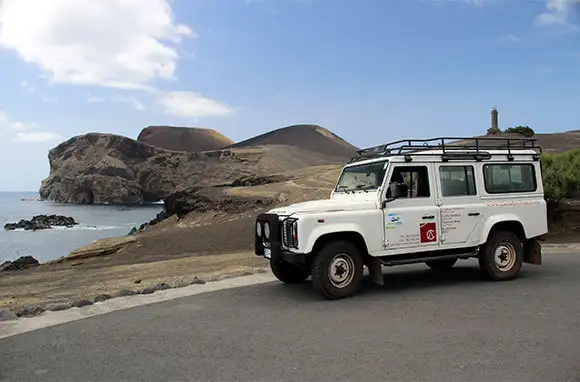
Jeep Tours with Casa D'Avilas
Whether descending into Caldeira on a nature walk or sampling the island's gastronomy, one of the most authentic and in-depth ways to see Faial is through the eyes of a local. Filipe Ávila, who is not only a guide but also manager of Casa d'Ávilas, is extraordinarily knowledgeable and passionate about the island and offers guests an intimate glimpse at it through jeep tours that stop at the popular spots but also rove well off the beaten path. He says it's "not the typical tour but more experiential, which is why we prefer to work with small groups. Everyone can see the same thing but the experience is different for all." He only allows six people per jeep, but tours can accommodate up to 12 with an extra vehicle and guide. Tours can also be customized and often don't keep to a strict schedule. He refers to visitors as guests rather than clients, and he explains, "We don't want them to see and leave. We adapt the experience to the people; your imagination is the limit."
Jeep tours cost €35 (about $47; check XE.com for current exchange rates) for a half day and €80 for a full day. Casa d'Ávilas also offers hiking excursions (including all the requisite permits) and rustic golf, where you can putt in the pastures alongside curious cows.
As for the guides, Ávila says, "We are storytellers." Indeed, they will openly share their love and deep respect for their island as you ramble along in the jeep, and the stories they tell of Faial may well be your best souvenirs.
You Might Also Like:
We hand-pick everything we recommend and select items through testing and reviews. Some products are sent to us free of charge with no incentive to offer a favorable review. We offer our unbiased opinions and do not accept compensation to review products. All items are in stock and prices are accurate at the time of publication. If you buy something through our links, we may earn a commission.
Top Fares From
Today's Top Travel Deals
Brought to you by ShermansTravel
France: 8-Night Paris, Avignon & Nice...
Infinity Worldwide Vacations
 vacation
$2880+
vacation
$2880+
Poconos: 3 Nts in Garden of...
ResortsAndLodges.com
 hotel
$305+
hotel
$305+
7-Nt Canada & New England Cruise,...
Princess Cruises
 cruise
$839+
cruise
$839+



